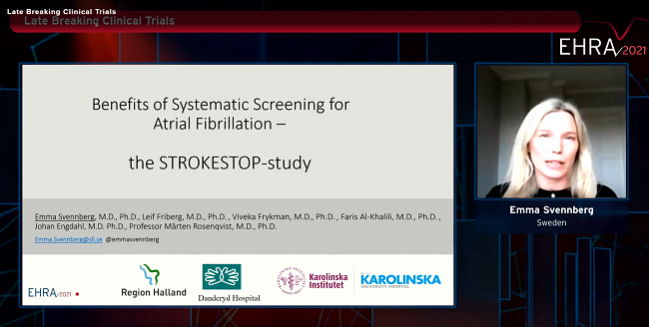STROKESTOP: Small Clinical Benefit Seen With Systematic AF Screening
The trial provides some welcome evidence suggesting that large-scale screening programs can reduce stroke rates.

A population-based screening program for atrial fibrillation (AF) improved clinical outcomes in 75- and 76-year-olds living in two regions of Sweden, the randomized STROKESTOP shows.
Over more than 5 years of follow-up, risk of the combined primary endpoint of ischemic stroke, systemic thromboembolism, all-cause mortality, hemorrhagic stroke, or hospitalization for bleeding was significantly lower in the group invited for screening (HR 0.96; P = 0.045), according to Emma Svennberg, MD, PhD (Karolinska Institutet, Stockholm, Sweden).
The number of people who would have to be invited for screening in order to prevent one event is 91, she reported last week during the virtual European Heart Rhythm Association Congress 2021.
“Population-based screening for atrial fibrillation provided a net clinical benefit in our elderly population,” Svennberg said, adding that “efforts should be made to increase participation in atrial fibrillation screening. Nonparticipants were at the highest risk of adverse events.”
Whether widespread screening for AF—with the aim of getting people with an undetected arrhythmia on oral anticoagulation to lower their risks of stroke and death—improves clinical outcomes has long been an area of interest. Recently, data from the mSToPS trial suggested that screening with a wearable ECG patch can reduce adverse clinical outcomes compared with usual care, but the study was not randomized.
Thus, a definitive test of the clinical impact of screening has been lacking, a point raised most recently by the US Preventive Services Task Force (USPSTF), which issued a draft document last week maintaining that there are insufficient data to weigh the benefits and harms of the practice.
STROKESTOP helps fill that gap. The study recruited residents ages 75 and 76 living in two regions of Sweden—Stockholm and Halland County. The participants were then randomized to be invited for screening or not. Follow-up was conducted for a minimum of 5 years using Swedish national registries.
The study included 13,979 people who were invited for screening and 13,996 who were not (mean age 76 years; 55% women). In the screening group, those without a prior diagnosis of AF underwent intermittent ECG recordings twice daily for 2 weeks. Systematic follow-up was arranged for patients with newly detected AF and those with a preexisting diagnosis who were not yet treated with oral anticoagulation.
Roughly half of the participants who were invited for screening (51.3%) were actually screened, and these individuals tended to be lower risk compared with those who did not respond to the invitation—they were slightly younger on average, had a lower mean CHA2DS2-VASc score, and had lower rates of various comorbidities.
The proportion of people with an AF diagnosis increased from about 12.1% to 14.0% in the invited group, whereas there was no change in the control group (the percentage remained around 12.8%).
Regarding the primary net clinical benefit endpoint, there were fewer events in the screening group (4,456 vs 4,616), indicating a “small but yet significant difference between the groups favoring screening,” Svennberg reported.
An as-treated analysis indicates that the difference was driven by a reduction in ischemic stroke in the participants who underwent screening versus those in the control group (HR 0.76; 95% CI 0.68-0.87). People who were invited for but did not undergo screening had the highest risk of ischemic stroke. “However, when looking at these figures we need to bear in mind that the participants were overall more healthy as compared to the nonparticipants,” Svennberg said.
Commenting on the results following Svennberg’s presentation, Renate Schnabel, MD (University Heart & Vascular Center Hamburg, Germany), pointed out that STROKESTOP is one of the first studies—if not the first study—to show a benefit from screening for AF.
She noted that the European AF guidelines provide a Class I recommendation for opportunistic AF screening in people 65 and older, with a weaker Class IIa recommendation to consider systematic screening in people 75 and older or in those at high risk for stroke.
The STROKESTOP investigators wisely, Schnabel said, enrolled people who were 75, a group that would be expected to have a high rate of AF detection and—by virtue of their age alone—have an indication for oral anticoagulation.
Overall event rates were lower than expected, but the curves started to separate between the screening and control groups after 4 years, indicating that “long-term effects appear to be relevant,” she said.
Schnabel said one of the major concerns associated with systematic screening programs is nonparticipation, and indeed, the people who chose not to participate in screening despite an invitation in the STROKESTOP study had the highest event rates. “Thus,” she stressed, “major efforts need to be taken to reach nonparticipants.”
During a panel discussion, Svennberg noted that geographic distance had a big impact on screening attendance. For the STROKESTOP II trial, which has completed enrollment, investigators situated the screening centers closer to residents to increase participation; results are expected after 2023.
Another issue raised by Schnabel was the need for a cost-effectiveness analysis, because the overall impact of screening was not great and the costs of systematic screening are “comparatively high.” STROKESTOP, she added, “now provides sound information for cost-effectiveness analyses, which to date have largely relied on assumptions.”
Future research also will assess whether large-scale screening approaches like the one employed in STROKESTOP will be bypassed by growing use of consumer-led screening using wearables and smartphone apps, Schnabel said.
“But for now, the future guidelines have gained strong evidence to judge on systematic atrial fibrillation screening by prolonged intermittent handheld device,” she concluded. “How to implement atrial fibrillation screening, including systematic screening in healthcare systems across Europe and beyond, remains an open question.”
Todd Neale is the Associate News Editor for TCTMD and a Senior Medical Journalist. He got his start in journalism at …
Read Full BioSources
Svennberg E. Benefits of systematic screening for atrial fibrillation – the STROKESTOP study. Presented at: EHRA 2021. April 23, 2021.
Disclosures
- Svennberg reports lecture/consulting fees from Bayer, Bristol-Myers Squibb, Pfizer, Boehringer Ingelheim, Merck Sharp & Dohme, and Sanofi, as well as institutional research grants from Roche Diagnostics and Carl Bennett Ltd.





Comments